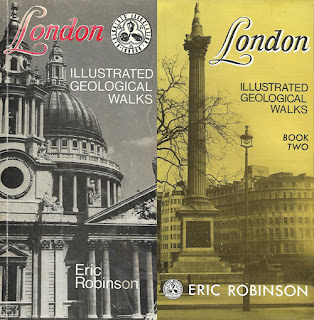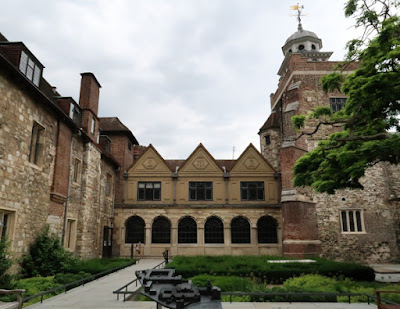When working in the building restoration industry in London, many years ago, I applied my degree in geology to the problem of stone identification and matching – to try and satisfy an architect's or a building surveyor's specification that would typically state: “All materials used for repairs shall match the existing as closely as possible”.
 |
| Various reference books used for stone matching |
With no formal training in this specialist field and in the days before the internet, I would rely on the Natural Stone Directory, various Building Research Establishment reports and other publications such as the Stones and Marbles of Wallonia, which I was given by Dr. Eric Groessens during a visit to Interbuild trade exhibition in Birmingham.
 |
| London - Illustrated Geological Walks |
Through practical experience, I soon learned the main types of stone that were used in the older buildings that I was working with; however, the two “London Illustrated Geological Walks” by Dr. Eric Robinson, sparked my interest in Urban Geology - with his work being continued by Dr. Ruth Siddall and the London Pavement Project and inspiring many others.
 |
| A publication inspired by Dr. Eric Robinson |
During my day out in the City of London, in June 2021, although my principal objective was to explore the London Wall, I couldn’t help noticing all kinds of stones; however, having explored the mediaeval churches in and around South Yorkshire in recent years, I was more interested in the traditional materials used in London’s buildings than the ubiquitous imported granites.
 |
| The Guildhall |
Leaving Guildhall Art Gallery, I had a quick look at the Guildhall, the administrative offices of the City of London that date back to 1440. The original building is constructed in Kentish Rag, a siliceous limestone of Cretaceous age, which was first shipped to London by the Romans from Maidstone in Kent. It was subsequently used for the mediaeval buildings, along with Reigate Stone, until Portland limestone became the dominant building stone during the C17.
 |
| A detail of Kentish Rag masonry at the Guildhall |
With still so much planned to see in the day, I didn’t explore this wonderful building and made my way back to Gresham Street and then to Basinghall Street, where I encountered the former Guildhall Library and Museum. Built in 1872 to a Gothic Revival style design by Sir Horace Jones, it again uses rock faced Kentish Rag for the walling, with Bath Stone for the dressings.
 |
| The former Guildhall Library and Museum |
Kentish Rag varies from very drab grey/green to grey/blue and, although a durable stone, it is very hard and intractable and incapable of being carved and I was therefore more interested in the wonderful grotesques carved in the Bath Stone.
When researching the locations of the remaining sections of the London Wall, in the time available I realised that it would be best to concentrate on the north-west part of the old walled city and, on Google Map, I was very curious about the fragment of a very old historic building that is sited just next to the road named London Wall.
 |
| The remains of the tower of the church of St. Alphege |
This is the remains of the mediaeval central tower of the former church of St. Alphege, dating to the C14. It is an ancient church that was built directly on London Wall and which has a long construction history, on both sides of the wall. This includes some damage during the Great Fire of London, rebuilding in 1777, further damage during WWI and demolition in 1923 – leaving only the tower, which was gutted by fire during WWII.
Bernard C. Worssam and Tim Tatton-Brown suggest that the assumption of Kentish Rag being suitable only for rubble walling, which I have generally adhered to, is not in fact correct. Living in the north of England, I haven't studied Kentish Rag or Reigate Stone but, nonetheless, if I examined them with the geologists' basic tools - a hand lens, a steel knife and hydrochloric acid - I think that I could readily distinguish them.
The dressings to the flint walling have been worked and shaped to a degree that I would not have expected, based on my experience of seeing many Kentish Rag churches in south London, where Bath Stone has been used for quoins, window surrounds etc; however, looking at the lamination of the dressings on my photos, I suspect that these could actually be Reigate Stone.
 |
| A view of the Charterhouse from Charterhouse Square |
Continuing my walk, after discovering further examples of Kentish Rag in the London Wall and flint at the church of St. Bartholomew the Great, which I will describe in detail in the near future, I unexpectedly encountered the Charterhouse, which lies just outside the City of London in the London Borough of Islington.
 |
| The entrance coutryard at the Charterhouse |
It was now 4 o’clock in the afternoon and, having been on the move for nearly 6 hours without a break, this complex of buildings looks like it needs a dedicated visit in its own right and I just took a few photographs of the parts that I could see.
 |
| Various building materials at the Charterhouse |
A mixture of materials can be seen in various phases of building and I was interested to see a further use of knapped flint, in a chequerboard pattern thyat decorates a boundary wall. I had seen a lot of flint buildings in the Chalk regions around the Weald in south-east England, when visiting English Heritage properties while living in London but, as a professional geologist, I have never investigated its use as a building material.
 |
| A boundary wall with a chequerboard pattern of knapped flint |




Always likeed to see plaques describing the building stone on structures around Toronto. Unfortunately there seems to be less embracing of architectural history as "developers" win out with increasing frequency over preservationists, and I have not discovered any new plaques in the last few years.
ReplyDeleteA good blog on the subject! Are there any plaques that tell one about the source of building stone on or around these structures??
ReplyDelete